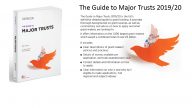Personal development, Presentations
Take the pain out of presentations: five top tips
Chrissie Wright, DSC Associate, provides five top tips ahead of her upcoming training course - Essential Presentation Skills.
It is most people’s experience that being asked to make a presentation gives you a stomach lurching shock and a feeling of fear that according to experts is right up there in the list of the universal ten worst human fears. So take comfort, if this is how you feel, you are not alone.
When it comes to preparing for a presentation, a tried and tested systematic approach can really help and build confidence to face the challenge with a positive mindset. Here are some tips to get you started:
1. Be clear about your purpose and think about your audience
Ask yourself what your overall purpose is (apart from getting the whole thing over with as quickly as possible!) – what is the key message you want your audience to take away with them and perhaps to do as a result?
Before you set about writing your message, find out as much as you can about your audience. How many people will there be? Why will they be there and what is their expectation, existing level of knowledge etc?
2. Structure your material
You are telling a story so create a framework with a beginning, middle and end. Mind-map your thoughts before deciding what to leave in and take out. Remember how long you have got and what your audience ‘must, should and could’ know.
Work separately on your opening and closing statements and remember you need to grab your audience’s attention in the first 30 seconds.
3. Work on controlling those nerves
You need some ‘nerves’ to perform well. The adrenaline rush that makes you feel nervous also makes you more alert and ready to give your best performance. Preparation is the key to success and knowing you have prepared well will help to overcome feelings of anxiety. Practise and time yourself as much as you can. Get a friend to listen and critique your performance or practise in front of a mirror and time yourself as well. We all tend to over-prepare for the time allotted.
4. Bring your presentation to life with stories, examples and anecdotes
Inject a funny anecdote into your presentation and your audience are more likely to engage. Use examples, relevant statistics and visual aids where possible, relevant to your audience’s context and experience. Don’t fall into the trap of too many slides, or too many words on a slide – remember they are VISUAL aids.
5. Remember body language and the power of your voice
Non-verbal communication carries most of the message. Good delivery conveys the speaker’s ideas clearly without distraction so avoid distracting gestures and remember to smile and maintain eye contact with your audience. Try to vary the pace and pitch of your voice. Always slow down and don’t be afraid of pauses.
Finally, good communication is never perfect, and nobody expects you to be perfect. Remember the audience is on your side and want you to do well. Putting in the time to prepare will help you deliver a better speech and you will always learn something useful for the next one.

